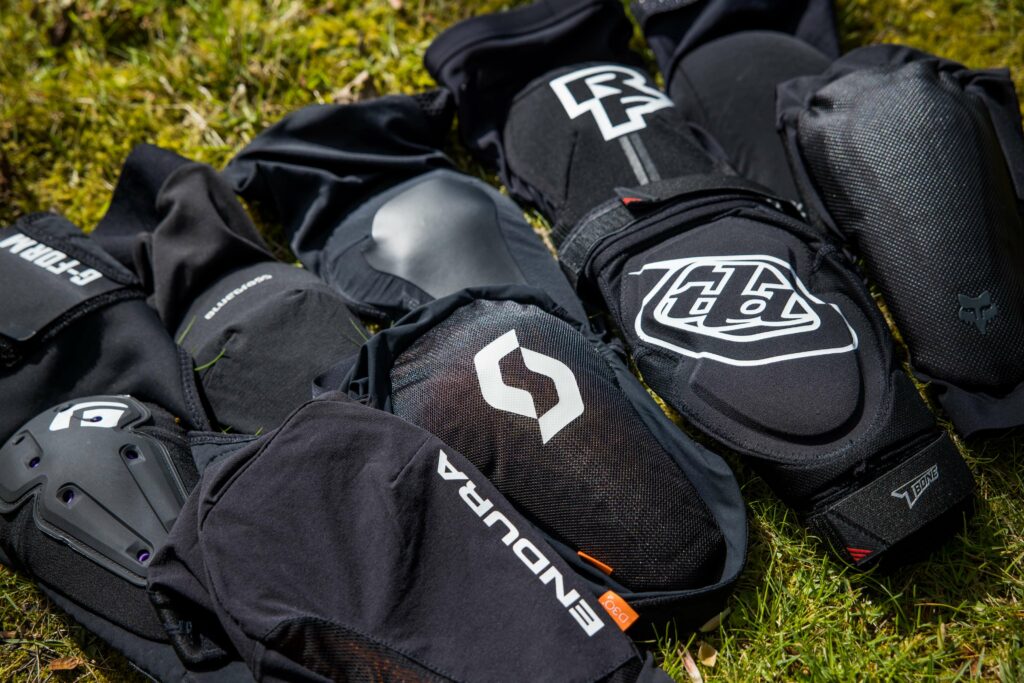
GROUPTEST
Knee pads
The best leg guards for pedalling-heavy days on the trails, rated for protection, comfort and versatility
In the rough-and-tumble world of mountain biking, taking a spill is a question of when, rather than if, so it’s a good idea to take basic precautions to protect yourself from injury. Wearing pads on the areas where your body is most likely to contact the ground – knees and elbows – is highly recommended. Even if you’re just protecting against scratches and bruises, it can save you from prolonged periods off the bike or annoying aches and pains down the line.
Like with most bits of riding kit, knee pad fit and feel can be subjective, because everyone’s legs are different shapes and sizes. While brands do their best to make pads fit a wide range of people, it’s unlikely that everyone will have the same experience with them. Pads that one person loves, others may find clumpy or even uncomfortable, go getting the right pair for your needs is crucial.
But what makes one pair of pads better than another? Most importantly, they need to feel comfortable on your legs – don’t just focus on your knee, think about your calf and thigh, too, because ill-fitting pads can make those bits sore. They also need to hug your legs, so that the protection can’t slip or move when you’re pedalling or if you hit the deck, without overly restricting movement, which can impair pedalling performance and comfort. Brands generally use hook-and-loop straps or elasticated sleeves, or a combination of both, to keep the protective knee cup in place, but effectiveness varies.
After fit and security, heat and sweat are the next considerations on pedalling-focused pads like those here. Perforations, breathable fabric and cut-outs can all be used to help keep your legs cooler. Note that, generally, the lighter the pads, the lower the level of protection. Here, we’ve focused on models designed for trail and enduro riding, which generally aren’t as bulky as downhill-specific pads. Knee protection varies from simple foam or hardshell plastic armour to high-tech viscoelastic materials (eg. D3O), which are flexible when pedalling but firm up upon impact. The nature and amount of material used varies between models.
We tested all the pads here back-to-back and with a different one on each leg to help highlight the differences between them.
DETAILS
ARTICULATION
If you can’t bend your knees easily when wearing a set of pads, then you’re not going to be able to ride your bike well. Bulky pads with a lot of coverage don’t always articulate as well as smaller, thinner ones, but this isn’t always the case. Well-positioned cut-outs, creases and pre-shaping can all help with flexibility.
COVERAGE
More coverage can be better. Some pads only cover the front of the knee, while others wrap around the sides, and can extend to the upper part of the shin.
CUT-OUTS
Usually found on the back of the knee, to aid articulation and comfort. Removing material here can reduce bunching and pinching, and also offer some cooling.
MESH
Perforated material is often used in key areas (such as the back of the knee) to help reduce heat build-up. Some finer mesh panels can snag and tear quite easily, though.
SIDE PADDING
Additional inserts on the sides can help protect your knees in a crash, or from knocking against your bike while riding. These tend to be made from foam.
STRAPS
Good strap positioning isn’t only crucial for comfort, but also to help keep the pads in place. If the straps are too small or big, or high or low, then they won’t feel quite right. Hook-andloop sections offer adjustability, but can snag your shorts/pants.
JARGON
SLEEVE
Making up most of the pad’s construction, this hugs your leg to anchor the knee cup and any side padding in place.
KNEE CUP
The bulk of the pad’s protection, this can be made from a soft, foam-like material, an impact-hardening one (such as D3O) or hard plastic. The protection is usually encased within the pad’s fabric and can be removable for washing.
D30
This material is soft and flexible but hardens instantly upon impact, making it ideal for protection. It can deform around your knees as you pedal, but then stiffens if you crash, helping to protect you.
SILICONE GRIPPERS
Pads without straps often have strips of silicone around the inside of their upper and lower hems to keep them in place. The silicone ‘sticks’ to your skin, stopping the pad from moving.
PROTECTION LEVELS
Some pads offer a certified EN 1612-1 protection rating. An anvil is dropped from a fixed height and the force transferred is measured, leading to a rating of CE Level 1 or 2 (more protective). The protection area is graded either A or B.
TROY LEE DESIGNS T-BONE
£79.99 https://saddleback.co.uk
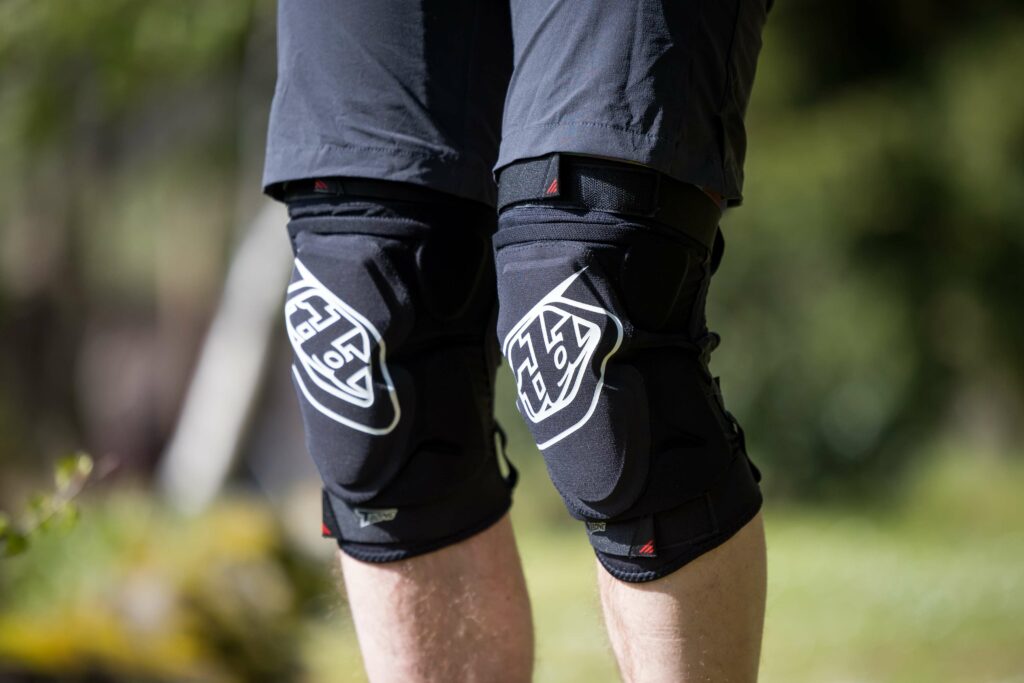
Troy Lee Designs’ T-Bones were the gravity rider’s choice in the early ’00s, but these newer versions have a lighter, more pedalling-friendly design, at a fair price. A pre-curved fit is combined with two Velcro straps, a band of silicone on the upper hem and four side inserts for additional protection. Stretchy material is used throughout, and the rear mesh has two cut-outs. We found that the elasticated Velcro thigh strap needs to be done up restrictively tight in order for the pads to stay in place. The shin strap, meanwhile, pulls the pads down unless cinched up firmly, which then limits leg articulation. Also, the knee cup is loose and baggy-feeling. General comfort is OK but not great, with no hot spots. The T-Bones stay relatively stable while riding, but aren’t as secure as some pads without straps. Coverage is good across the knee and on the sides, but the pad itself – made from a mix of foams and thermoplastic rubber – doesn’t offer much shin protection, especially for longer legs. The ‘hooks’ of the Velcro straps point outwards, so snag on clothes. While this doesn’t impede movement, it does reduce how refined the pads feel. They aren’t particularly hot and are relatively light, but their overall comfort and fit makes them less suited to long days in the saddle than others here.
POC VPD AIR FLOW
£130 www.pocsports.com
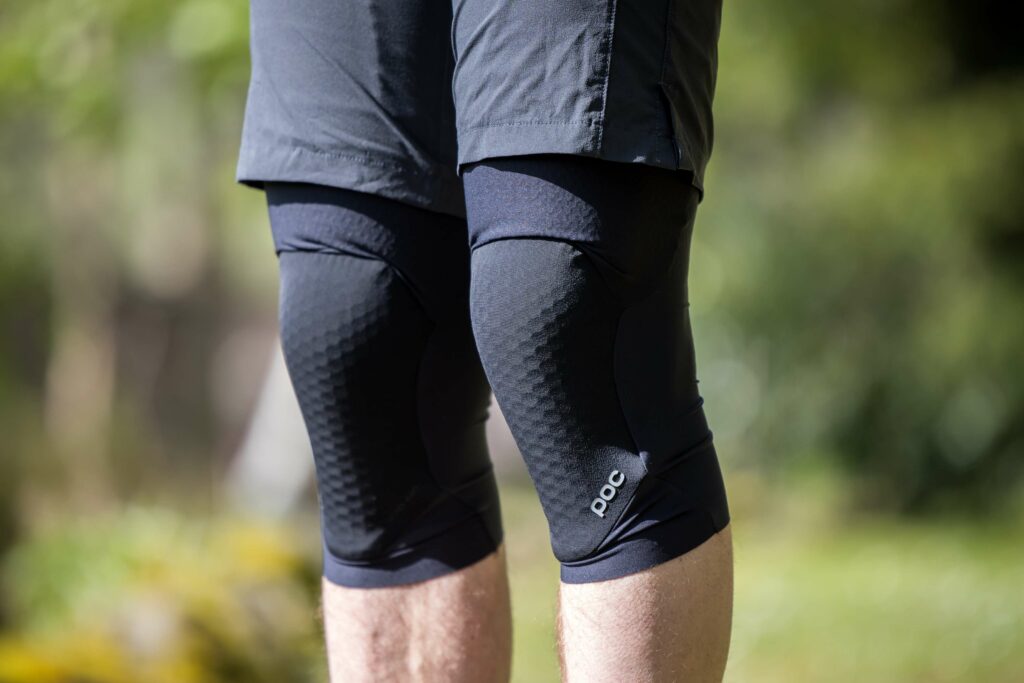
With no straps, the lightweight Air Flow pads rely on a long sleeve that extends up the thigh and down the shin, with a silicone bead to help it grip your skin. The knee cup is made from POC’s ‘VPD’ material (Viscoelastic Polymer Dough), which hardens on impact to provide protection, but remains flexible and soft when manipulated. A mere two seams further boost comfort. All this minimalism does result in a high price tag, though. If set high on the knees, the elastic upper hem lacks the strength to keep the pads from lifting with each pedal stroke, causing them to twist. The short lower hem – which doesn’t have any silicone gripper – has a tendency to bunch up, into the bend of your knee. Fortunately, the soft, thin material prevents this from causing any discomfort or hot spots. Most of this unwanted movement happens only while pedalling, and the pads are more stable on downhills. They’re impressively flexible and lightweight, and don’t restrict your legs. But the trade-off for that freedom of movement is less protection. They could extend further down the shin with only a limited weight penalty. As it stands, prioritising comfort and light weight over protection has led to one design compromise too many.
RACE FACE INDY
£84.95 www.silverfish-uk.com
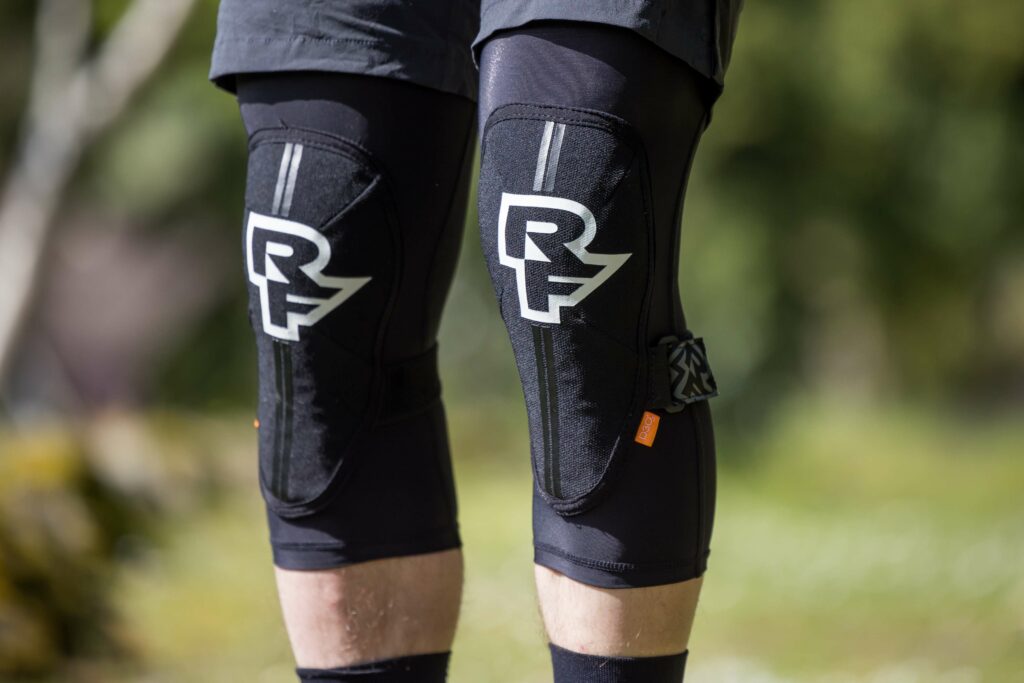
The Race Face Indys are designed to offer breathable all-day comfort thanks to a nylon, polyester and Lycra-mix fabric. Protection is provided by a removable (for washing), ventilated D3O LP1 insert. These pads are on the lighter side, with a single, elasticated hook-and-loop strap and no additional side protection. The upper and lower hems have silicone bands to help keep them in place, and flatlock seams give a smooth feel. Although Race Face offer sizes up to XXL, larger riders may struggle to find a pair that fits correctly. The strap can be felt on the rear of your knee, especially when your leg is bent. This doesn’t cause irritation, but means the pads lack that ‘blend into the background’ feel. Despite the ‘hooks’ pointing inwards, the edges of the strap still got caught on our clothes at times. This isn’t a deal-breaker, but does affect the overall feel. While not restrictive or uncomfortable, you know you’re wearing the Indys, but they don’t slip around and no on-bike readjustment is required. Frontal knee protection is good, but with no side panels and a fairly short D3O insert, coverage is limited. We’d like them to extend further down the shin and have some side padding. Generally, however, comfort and protection are good.
G-FORM MESA MTB
£119.99 https://g-form.com
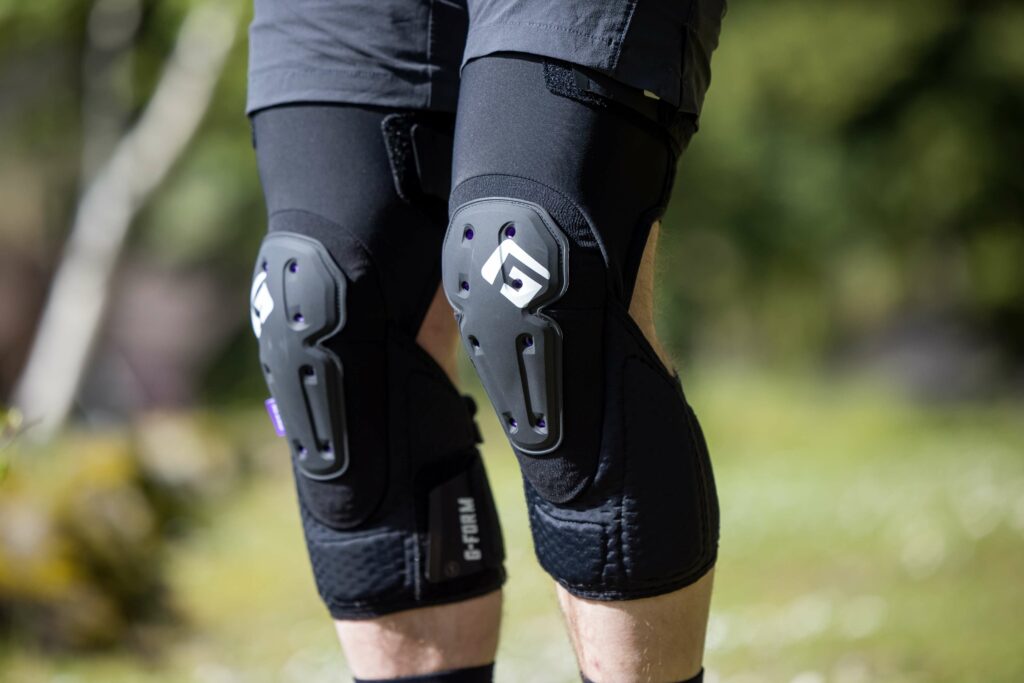
G-Form’s new Mesas offer enhanced Level 2 protection while being made from eco-friendly materials. The ‘RE ZRO’ knee cup has side-facing pads for increased protection, plus a flexible hardshell skid plate on the front. Three hook-and-loop straps – one on the front, two on the rear – let you adjust the fit, while a zip on the shin means you can fit and remove the pads with shoes on. They’re made from a stretchy, tear-resistant material, with flatlock stitching used throughout. The multiple skin-facing panels are mesh-backed, to boost comfort. Between the thigh-high upper fixing point and shin-level lower, there’s a rear cut-out to improve comfort and expel heat. Thanks to the tri-strap design, there are multiple adjustment options – which is handy, because we found it tricky to find a comfy fit. If the straps are done up too tight, the rear cut-out pinches when you bend your knee; too loose, and the pads become unstable. Once the right tension is set, though, they don’t move when climbing or descending. The Mesas hug your legs well and don’t feel too bulky despite their size and weight, helping them to fade into the background, even if they are fairly hot. With plenty of protection, these are good pads for meaty descents.
SCOTT SOLDIER
£79.99 www.scott-sports.com
Scott’s Soldiers use a removable, ventilated D3O LP1 insert and come in at a reasonable £80. They have a strap-free design, using a stretch-fabric sleeve, with silicone gripper around the upper hem. When you bend your knee, the lower hem rises and bunches up. This doesn’t cause the padding to move, but does leave your shins feeling exposed if wearing shorts. A tighter hem, sitting further down the calf, with some silicone beading, would reduce this. The upper gripper sticks to your skin well, while the material hugs your thigh. If the D3O is cold, there are pressure points on the inside of the knee cup, but these vanish once you start pedalling and it warms up. The cup has quite a baggy fit, and contacts your knee as you pedal. While this doesn’t cause discomfort, it’d be better if it sat against your skin permanently. Despite this, the Soldier pads remain stable when pedalling and descending, and need no re-adjustment while riding. Plus, the fabric doesn’t pinch or bunch up. Protection is good for the weight, although a longer shin section and some additional side protection would be an improvement. However, all-day comfort is great – the Scott pads are unnoticeable after 30 minutes or so of riding.
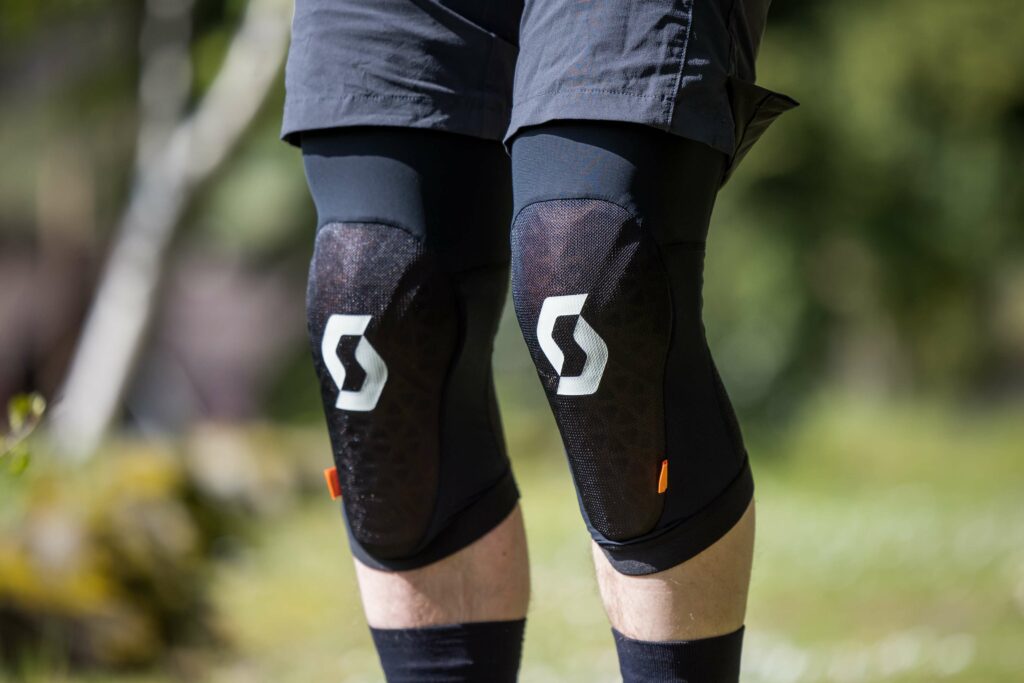
ENDURA MT500 D3O GHOST
£89.99 www.endurasport.com
These pads feature D3O’s Ghost insert, which is their thinnest and most flexible offering, but still provides Level 1 protection. Endura have added external neoprene padding on the pad’s outside edge, plus a front panel made from ripstop material. The mesh backing is designed to wick sweat away. There’s silicone gripper on the elasticated top and bottom openings to help the pads stay in place. Sizing is on the smaller side and the sporty cut may not work for bigger riders. If the pads do fit you, though, their malleable design means comfort levels are exemplary. They flex and move in sync with your knees, ensuring there are no pinch points or hot spots, staying glued in place and never sagging, lifting or twisting. Internally, though, they’re not the smoothest – the angles of the Ghost insert can be felt through the fabric, although this doesn’t impact overall comfort. Knee protection is wide and long for the weight, but we’d prefer it if the coverage extended further down the shin. The neoprene side protectors are good, but we’d like some inside, too. Impressively comfy and quite airy, too, the MT500 D3O Ghosts offer all-day performance, whether pedalling or descending. The irregular sizing may not work for some riders, though.
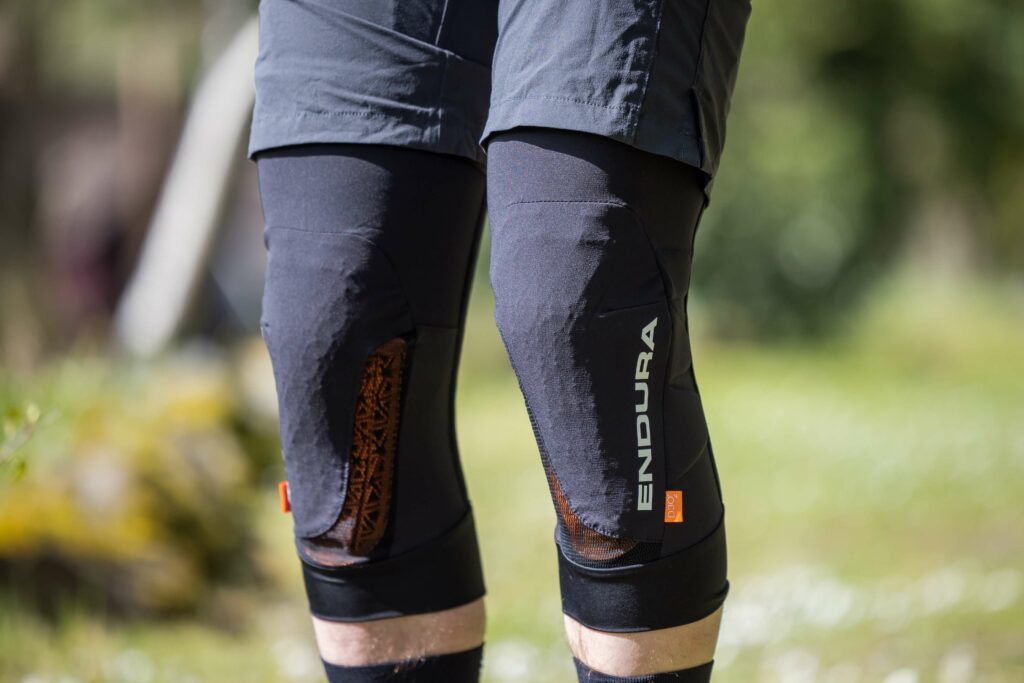
PEARL IZUMI SUMMIT
£76.50 www.pearlizumi.eu
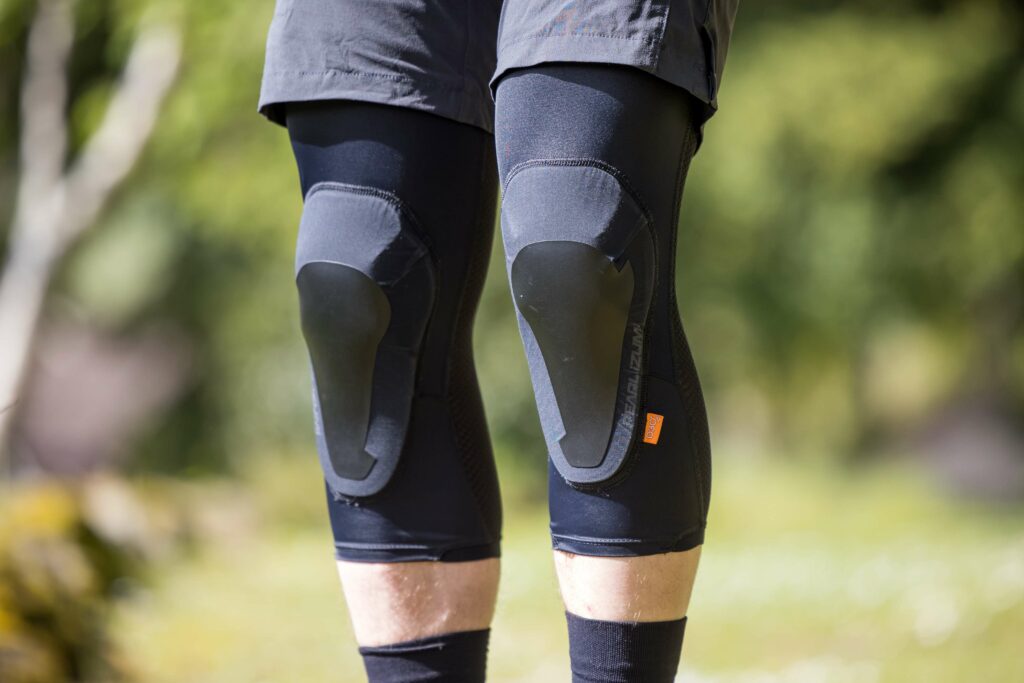
Pearl Izumi’s Summits are affordable and light, but still achieve CE Level 1 certification, thanks to use of a sheet (rather than pre-formed insert) of D3O material. Tough, four-way stretch Cordura fabric covers the front, while the back is breathable mesh. The sleeve extends high up the thigh and down the shin, and the upper and lower hems both have silicone beading. Flatlock seams feature throughout, boosting comfort. Designed for all-day comfort, with a snug but not overly tight fit, the Summits stay in place without restricting leg movement or knee articulation, and conform well to the shape of your legs. The lack of seams eradicates hot spots, the pads don’t lift or slip, and the silicone grippers and elasticity keep them from bunching at the back. Internally, they’re not particularly soft, but are smooth, which reduces rubbing. Externally, their smooth surfaces mean they don’t snag on clothes. For their size and weight, protection levels are good, apart from at the side, but this is no worse than on other comparable pads. A fit-and-forget, adjustment-free package, it’s easy to forget you’re wearing them during long days in the saddle, as they’re exceptionally comfortable. Trail and enduro riders alike will appreciate the Summits.
BLUEGRASS AURA
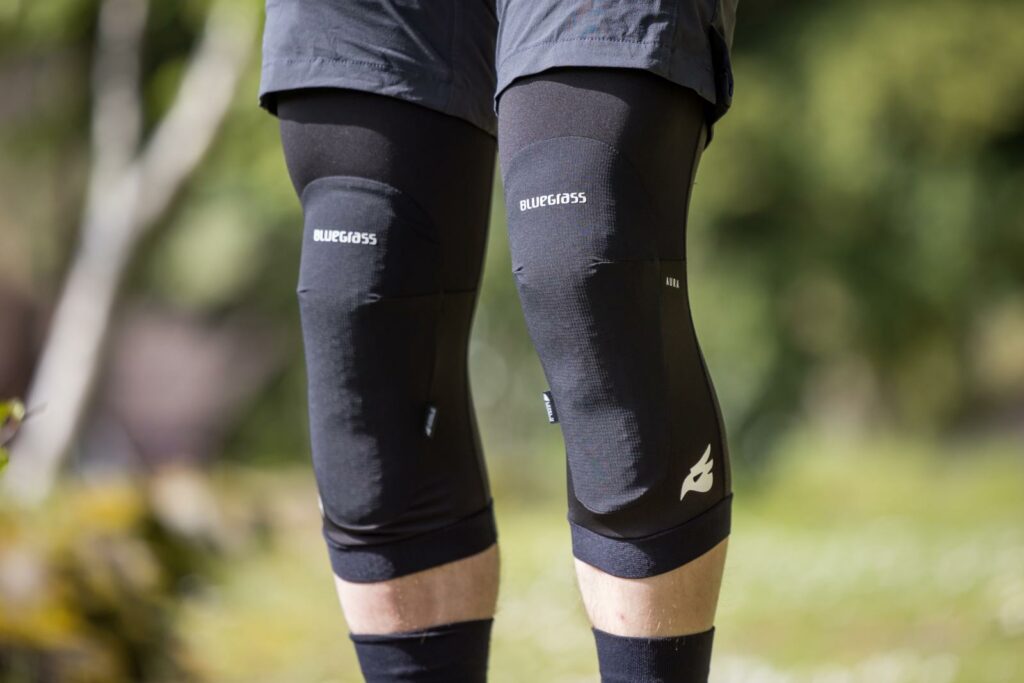
Bluegrass’s new Aura pads are the lightest in their range but still boast a higher CE Level 2 protection rating, at a good price. Their design prioritises freedom of movement, using a four-way stretch sleeve with no elastic or Velcro straps to keep bulk to a minimum. Both the upper and lower stretchy hems have a wide band of silicone beading to grip your skin. At the rear, a section of thin, seamless mesh helps dump heat and boost comfort. The flexible knee cup sits in a seam-free pocket. Bluegrass forgo side padding to reduce weight. When you first put the pads on, there’s a pressure point on the inside of the knees, but once they’ve warmed up (10 to 15 minutes), comfort improves dramatically. The Auras hug – but don’t squeeze – your legs, and feel secure without restricting movement. Because the long sleeve extends high up the thigh and low down the shin, it keeps them in place nicely. Internally, they’re smooth and soft, with no perceptible seams. Externally, they slide freely under clothes. Articulating well, these pads are great for long days in the saddle. There’s no bunching of fabric, and, with plenty of padding, they offer a good level of protection without feeling at all clumpy.
FOX LAUNCH ELITE
£144.99 https://foxracing.co.uk
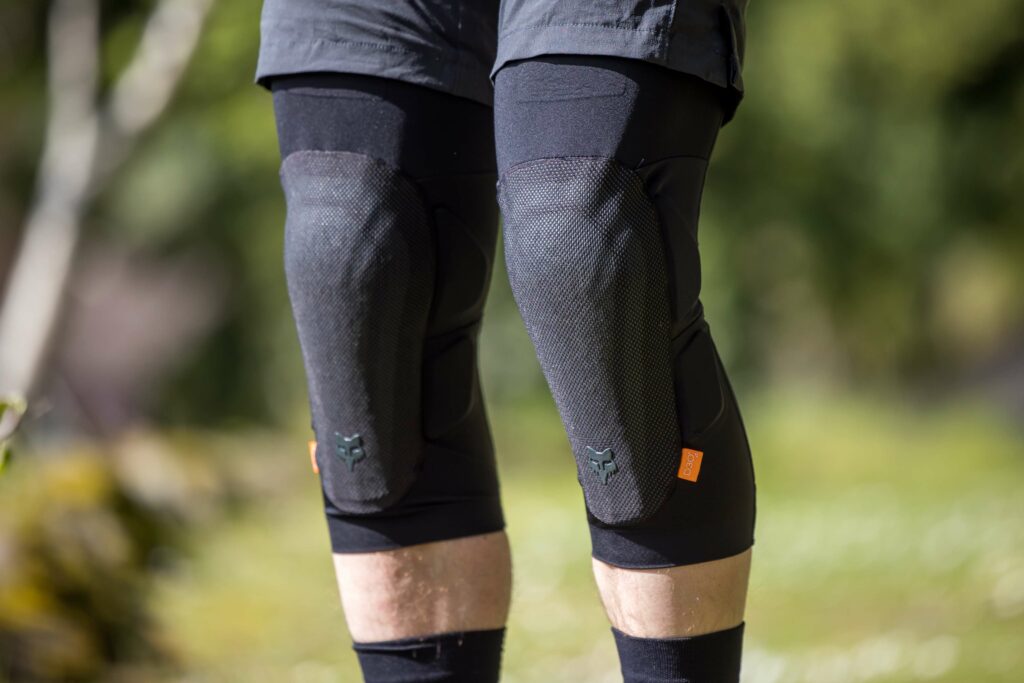
The Launch Elites forgo any elasticated or hook-and-loop straps, instead relying on a lightweight sleeve with elastic panels at the thigh and shin, plus silicone gripper around the upper hem. Fox use a malleable D3O LP1 insert, which can be removed when washing the pads. Padding extends a decent way down the shin, with four foam-like ‘pods’ at the sides, too. Externally, the protection area is covered with a ‘SuperFabric’ skid panel to protect the Lycra from tears. Inside, the almost seam-free design gives a smooth feel against your skin. The sleeve has an elastic section at the thigh, which spreads its grip evenly. Combined with the half-elastic lower opening, this provides a good blend of comfort and compression. The knee cup and side pads follow your leg movements as you pedal. Despite the figure-hugging design, the Launch Elites are unrestrictive and unobtrusive. They don’t move up or down, or twist, and don’t need re-adjusting while riding, either. The front padding offers good shin coverage, while the smaller side panels boost protection further and are neither too short, too narrow nor too bulky. These pads slide under shorts and trousers nicely, too, thanks to their smooth exterior.